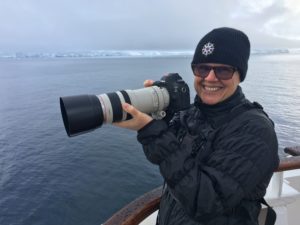Shooting in the polar regions offers some incredible opportunities for capturing rare wildlife sightings and natural phenomena such as the northern lights. To make the best of your trip, be prepared for the cold. The following tips will help you protect your camera, batteries, and body from the chill.
- Store extra batteries fully charged and warm inside your parka. I use the inside chest pocket, so they are close to my body.
- Bring at least three camera batteries so that you have two spares ready to go. You don’t want to miss a shot when the low temperatures shorten the life of the battery.
- Ensure your pockets are empty before slipping your batteries in your jacket. Loose change in contact with battery terminals can cause a fire!
- Cover battery terminals with low-adhesive first-aid tape or put them in a plastic cover or box.
- Wear liners under your thick gloves. If you are using a smartphone, then get glove liners that can operate the phone.
- Store your camera in a waterproof backpack or collapsible insulated soft cooler in order to keep the camera warm and dry in the field.
- Use a lens blower to remove snow from the lens.
- Keep your lens covered with a lens cap to keep frost away.
- Consider using a lens hood to protect the lens from blowing snow.
- Place your camera in a plastic ziplock or dry bag inside your backpack and allow it to warm very slowly by a window indoors to prevent fog. By leaving it in a ziplock full of dry air, it can slowly rewarm without condensation landing on the camera and lens.
- Moisture will eventually evaporate if the equipment is allowed to warm up slowly. You can gently warm the gear with a hair drier on low or a fan.
- If you get condensation on your camera, turn off the camera and take out the batteries to prevent damage.
- At extremely low temperatures, you can use hand warmers on the battery grip of the camera to help retain battery power.
- The camera display can be affected by extremely cold temperatures. The LCD can lose contrast and work slower than usual. It will be recover when it warms up but bear in mind to use histograms for reviewing exposures rather than the display for making exposure judgment calls.
- Consider getting a lightweight carbon-fiber tripod or insulation for metal legs. Beware of bare skin touching anything metal and try to keep your tripod as dry as possible to avoid freezing the legs open or shut.
- In white snowy conditions, you should dial in +1 or +2 stops of exposure compensation if you want white snow to be white, and not an 18-percent grey. Check your camera manual to determine if your camera corrects the exposure with evaluative metering.
